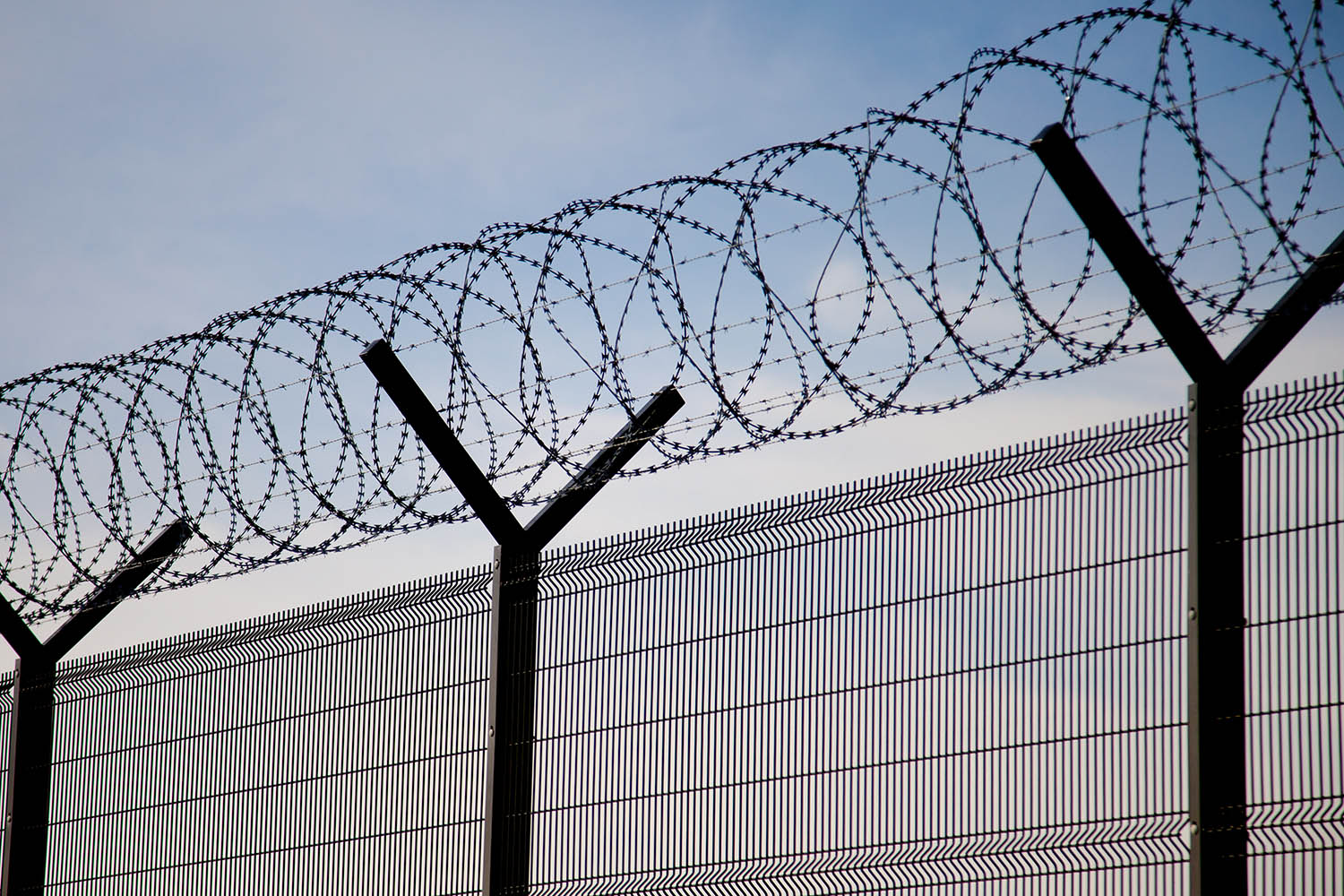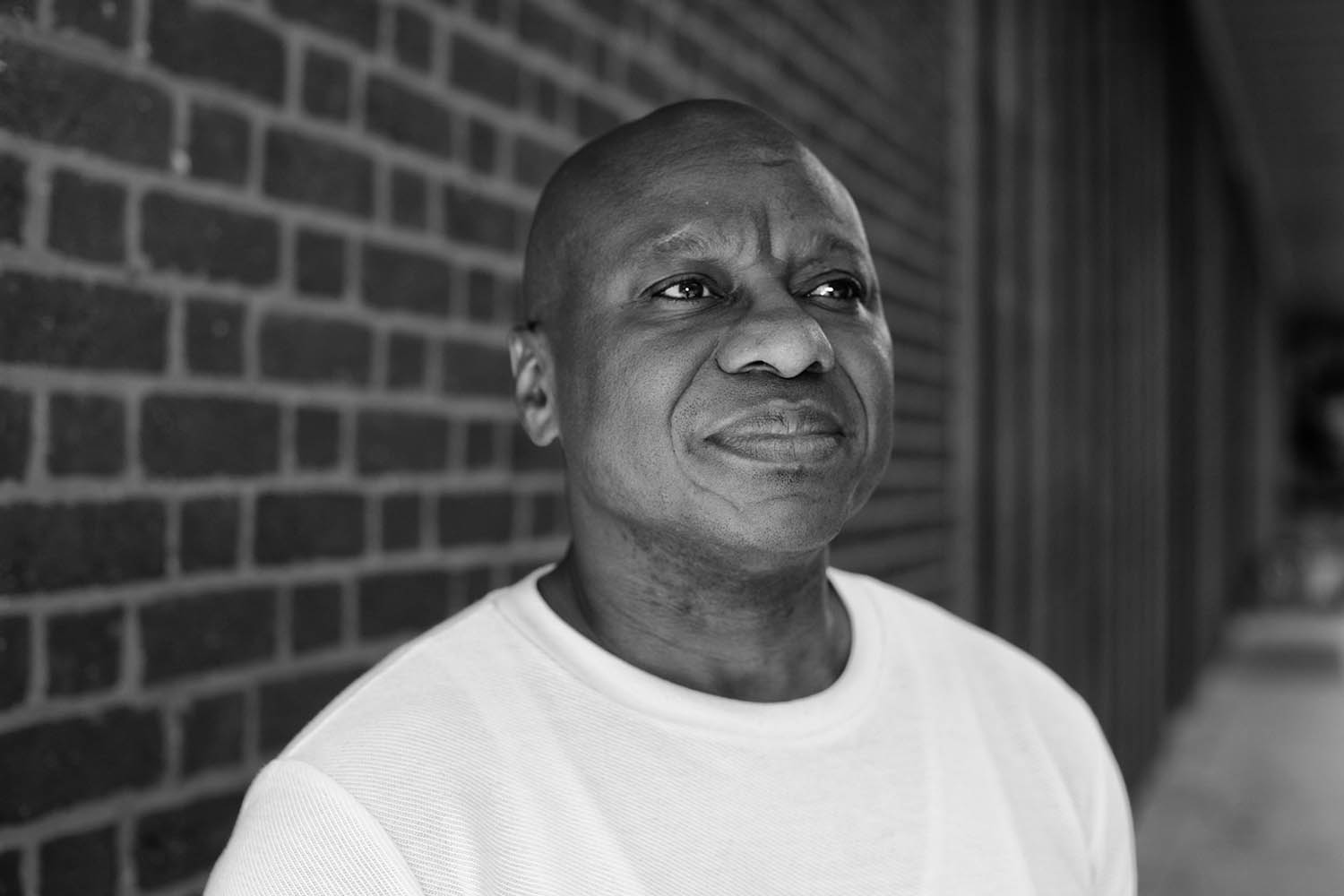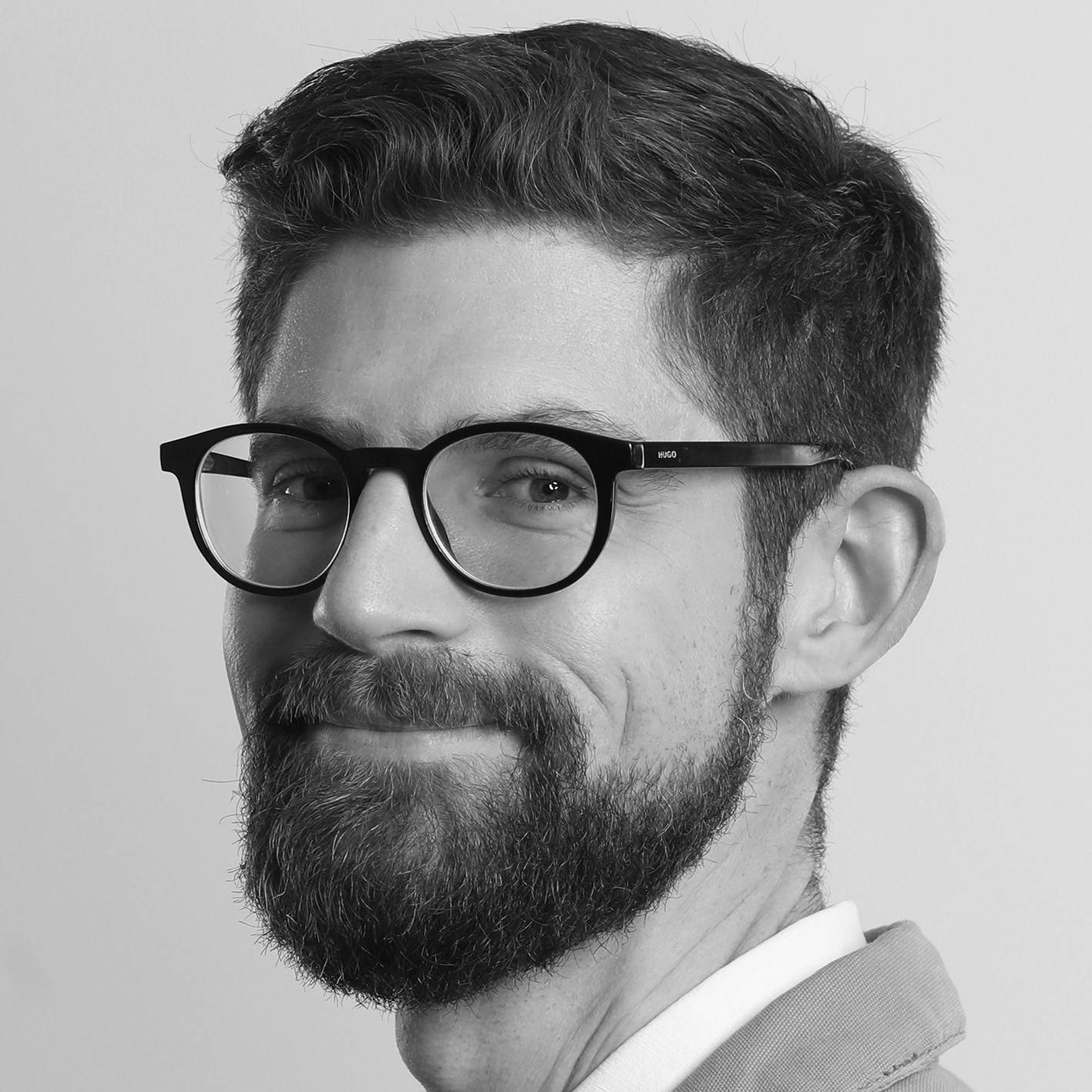Portrait by Sophia Evans
Pious Keku is counting doors. He takes a mental note on the way in, he tells me, so he knows the way out. As I lead him downstairs and through the Observer office corridors, I swipe my pass several times before we reach a small room where our interview will take place. Gently, I push the sliding door shut. This is a situation he has been in many times before. It has rarely had a happy outcome.
Keku is 47 and a former refugee from Ghana. He was detained for almost three years between 2010 and 2013, during which time he was moved “10 or 11” times between sites: he believes he was held in every detention centre in the UK. (Some have since been closed: there are now seven functioning centres.) He has been ushered through countless doors, in police stations and the cellblocks of Brook House in Gatwick or the immigration removal centre – a former prison on the site of a Napoleonic wars-era fort – in Dover.
The first time he was released from detention he had to check in at a Home Office outpost every week. After six months, he says: “I went one day to sign in. As you go to the counter with your pieces of paper, they just say: ‘Oh, we need you for an interview. So can you come through this door?’ You go through the door, and that’s the end of me. I find myself back in detention. If you’re in my position,” Keku says, “you’ll never have any trust for anybody.”
Yet there are some who have won his trust: members of the Gatwick Detainees Welfare Group (GDWG), the organisation that made contact with Keku and helped to secure his freedom. In 2015, the GDWG set up a project, Refugee Tales, pairing established writers with “individuals who have direct experience of Britain’s policy of indefinite immigration detention” for stories modelled on the pilgrims’ narratives in Chaucer’s Canterbury Tales. Keku was introduced to the novelist Ali Smith, who wrote his story, published as The Detainee’s Tale in the first Refugee Tales anthology.
Our meeting today, on its 10th anniversary, has been brokered by Anna Pincus, the director of GDWG, who Keku relies on as a gatekeeper: “Unless I hear from her, I’m not going to answer your call, or say anything to you.” Here in a basement meeting room, he sits across the table, dressed in a plain T-shirt. There is a stillness to him but he never quite relaxes. His eyes seem small behind his glasses, a frown gathering when he is asked to remember his past. A 2-litre bottle of water sits beside him. He has brought a friend from GDWG, who occasionally reminds Keku to take a break and have a drink. He speaks with deliberation, slowly at first. This is not an interrogation but the ghosts of past interrogations are in the room.
Keku’s story begins in northern Ghana. By the age of six – as far back as he can remember – he was a farm labourer. Every day, “whether raining or shining”, he would walk up to five miles with a group of other children from their hut in the village to the farm where they worked, harvesting cocoa and plantain. “We used to go to school under the tree, but at some point they stopped us from going because they wanted us to work.” He grew up thinking the adults in charge were his parents. But when Keku was older he discovered that his mother, a Christian, had died when he was two or three years old. His father’s family was Muslim and – faced with a child of another religion – “had to sell me out”. Keku’s “parents” were in fact his overseers, and owners.

‘Detention does not help. It is dehumanising’
When Keku was a teenager, he and three others attempted to escape, but they were caught. “I remember that on the first attempt, we were beaten up very [badly]. If you got a cut, you couldn’t put a plaster on; you just had to grind some herbs and then squeeze the water into it and leave it to heal. I still have scars on my body.”
Ghana is the world’s second largest exporter of cocoa, and its economy is one of the most reliant on child labour. Twice a month, a lorry arrived to pick up the beans. One day, a driver saw Keku’s wounds and told him to get out: “If not,” he said, “you’ll be here till you grow very old.” There was a place, the driver said, where they could be paid for their work.
Keku and his companions slipped away from the farm and walked to the nearest village, where they were offered accommodation. Men came and took photographs of them; passports were prepared. “Then, one day, they came to pick us up deep in the night and we travelled to Accra.” Hours later, they flew from Ghana’s capital to the UK. When they arrived, “we just entered a car and went to a house. And that is how the trafficking started.”
For three years, this was Keku’s existence. There were 15 to 20 people living in a three-bedroom house in Luton: some were from Ghana, some from other countries. The bedroom door was kept locked. They slept on mattresses on the floor. “We woke up at dawn and were driven to a warehouse where we worked the whole day – for 16 to 18 hours.”
The work was packing shoes and clothes, and cleaning electrical appliances. They would be given “a Coke and some bread, or sometimes biscuits” for sustenance; chips and chicken “on a good day”. There was one shower but at the end of the day they were often too tired to do anything but sleep. Over the years, they were moved between different houses. Keku lost his companions. There were glimpses of life outside. On the drive to work, he would see the cars and tarmac roads and marvel at their difference from the bare, sandy tracks of Ghana.
When vans came to pick up the goods, the warehouse shutters were closed behind them. Later, Keku realised: “They were protecting themselves. They knew very well what they were doing was wrong.” For the second time, a driver noticed Keku, and offered to help him. For the second time, he escaped.
In London, he went to a police station and told them: “Look, this is the situation. I’ve got nobody in this country. They said: ‘OK, somebody is going to come to speak with you.’” Then they locked him in a cell. The following day, an official came: “He said he’s from immigration. He said we have to take you to a place where you are going to be helped.”
On the third day, Keku was led from his cell in handcuffs and placed in a van. He silently accepted his fate. “The way I was brought up, you don’t question. When you question, you get beaten.” He believed he was going to be deported to Ghana.
The van arrived at a building and was allowed through a set of large gates. He waited in a locked waiting area for several hours. Then he was called into a room, photographed and fingerprinted. “They said: ‘Now, here is going to be your new home.’ In my head, I was happy.” Keku recalled all the security measures at the airport, and took comfort. “I thought: ‘Oh, this is something they do here. You have to go through all these things before you get to your home.’” But then he saw corridors and closed doors. And when he was shown his room, he realised it was not a home.
In the detention centre, Keku retreated into himself. Some days he would not eat. “I wasn’t myself,” he says. “I never had any hope. I just thought: ‘This is going to be my life.’” He was told that he should speak to somebody, “but I never did”. He assumed that if you talk, “the next thing is that they’re going to take you back to your country”. Eventually, a resident chaplain persuaded him to accept a visit from Anna Pincus of the GDWG. On their first two meetings, Keku did not speak, but on the third, he slowly found the ability to trust another person with his story.
He saw corridors and closed doors. And when he was shown his room, he realised it was not a home
Pincus and her organisation advocated for Keku’s release from detention. His freedom, though, came with its own form of shackles. While his application for leave to remain made its tortuous progress through the courts, he had to continue to sign in at an office in Croydon, south London, every week. He was not allowed to work, nor was he eligible for any government support. Without help from GDWG, he almost certainly would have been deported: “It happened to some people. They could not afford the train fare to go and report, and then the Home Office term it as ‘absconding’, knowing very well that they have created the problem.”
It took a further eight years for Keku to be granted leave to remain. He was given the news in February 2020, just before the first Covid lockdown. “Under normal circumstances, you should be celebrating. But I have to be honest, I wasn’t happy at all. Yes, it is true they’ve granted me leave as a refugee to stay. But how do I know I will not be arrested again?” Lines appear on his brow. It took him “quite some time” to shake off the detention mindset.
Meanwhile, after their initial meetings in 2015, he and Ali Smith had become friends. They both went on the inaugural Refugee Tales walk, from Dover to Crawley: a pilgrimage of 10 days. In the evenings, there was storytelling and music. On the day Smith was due to read his story, he needed “a lot of emotional support”. When it happened, after a couple of minutes he had to leave the room. “It was just too much for me to hear.” Since then, Keku seems to have learned to accept – and take ownership of – his story. He has visited Smith at home several times, and they still speak on the phone.
Since 2020, Keku has studied at university, qualified as a social worker and become a trustee of GDWG. He has spoken to politicians in parliament and campaigned for a 28-day limit on detention for asylum seekers – as recommended by a 2023 report on the inquiry into the mistreatment of detainees at Brook House, largely ignored by the government. “Detention does not help,” he says. “It is dehumanising.” Having learned that about £46,000 a year would have been spent on his incarceration, Keku is amazed at the economic illogic: “If you release these people while they are waiting for their cases to be decided, they could be contributing to the economy.”
A friend of Keku’s from the Refugee Tales walks was recently racially attacked in the north of England. “He was just sitting in the park. You can see the fear in him now. He will continue to be afraid for [the rest of ]his life. Why would they say: ‘Foreigners are coming to our country, taking all the school places, taking benefits’? It’s not a fact. I’ve been in this country for years and never taken a single benefit.” Even if Keku wanted to, he adds, he could not: a condition of the leave to remain is no access to any public funds – Keku was not even eligible for a student loan. “Our aim,” he says, “is to look at people as human beings.”
I ask Keku if, in his work with GDWG, he has visited refugees in detention. “That’s the only thing I have not done yet, but it’s a plan I have. But I want to be totally ‘held’ and to have the strength to go into the process: signing in, going through all those gates – gate, gate, gate – before you go into the visitors’ hall. Psychologically, I’m not there yet.”
His memory is a place of opening and shutting doors. “The impact of detention is still there. On a daily basis, it comes into your mind. It’s not something that I can just erase.”
The 2025 Refugee Tales walk is from 9 to 13 July; refugeetales.org
More on Refugee Tales
Portrait of Pious Keku by Sophia Evans for The Observer

